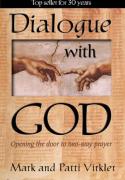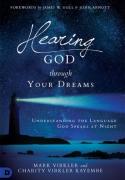by Dr. Mark Virkler
I desire earnestly to live as Jesus did, out of the Fathers initiative, doing only what He saw His Father doing (Jn. 5:19,20; 8:38). However, before I could live that way, I needed first to learn how to become a seer. In a rationalistic culture where seeing with the eyes of the heart is generally looked upon with scorn, it takes a monumental effort to become at ease with seeing vision as Jesus did. It is a huge step even to believe that such a thing is possible.
My experience, as well as the experience of many others, has convinced me that once we have grown accustomed to looking expectantly into the spirit world for a vision from the Lord, it most readily appears. The simple act of looking in faith opens one up to begin seeing that which is there.
I am convinced that the spirit world is there, whether or not I am seeing it. In becoming a seer I am simply learning to see what is. In learning to see, I am learning to bring alive an atrophied sense (i.e., my visionary capacity) and then present it to God to be filled.
Once my visionary sense has been rejuvenated and presented before Almighty God, I am offered the opportunity to live as did Jesus of Nazareth, out of the continuous flow of divine vision.
The Prophets of Israel could simply say, I looked, and as they quieted themselves before God, they saw (Dan. 7:2,9;13). I have found that once I have reclaimed the use of my visionary capacity, I too can simply quiet myself in the Lords presence, look, and see the visions of Almighty God. I am a seer simply because I have become a looker.
The Bible says we have not because we ask not. For years I never saw, because I never looked. As I teach people to look, I find that they become seers. This sounds simple, and it is for many, particularly those who are intuitive, spontaneous, and visionary by nature, and who have not allowed the pressure of a culture which idolizes logical, analytical and cognitive functions to cut off their natural, spontaneous openness to vision.
However, for those like myself, who were born naturally logical, analytical and cognitive and have had these inherent leanings reinforced by the rationalism of their culture, seeing the vision of God may not be so easy. Often the intuitive and visionary functions have literally atrophied and died through lack of use; therefore, for these people, the process in not as simple as just looking and seeing. Even as a muscle which has atrophied through lack of use must be exercised in order to restore its vitality, so must an unused, and thus atrophied, sense be exercised.
This involves three steps:
- Repenting of the sin of scorning that which God has created,
- asking God to breathe new life into this inner sense of seeing, and
- developing this sense which God is restoring.
This development involves standing (in belief that God will do this), taking the first wobbly steps, and gaining strength to the point of walking with ease, allowing God to direct the pathway.
This is exactly what has happened with vision in my life, as well as in the lives of many others. Through the scorn heaped upon it, and through continuous disuse, my visionary capacity had atrophied and died. Therefore, when I began looking to see the vision God wanted to present to me, I saw nothing. I had so scorned my visionary capacity that it was unable to function when called upon to do so.
As pastors have often preached, our heart is like a radio; we must tune it so we can hear Gods voice. We must also tune it to see Gods vision. However, in this case, my hearts
I began the process of restoration by repenting of my scorn toward my visionary capacity. I asked Gods forgiveness for not honoring and using that which He had created and given me. I also repented of participating in the idolization of logic and analytical thinking which had swept over me, as well as over my culture. I covenanted to honor and seek His ability to flow through vision as much as I had honored and sought His ability to flow through analytical thought.
Then I asked God to breathe upon my visionary capacity and restore it, to bring it back to life and teach me how to allow Him to flow through it.
Now I was ready to take my first few wobbly steps. As I sat in my study seeking Gods face, I was drawn to a scene from John 4 in which Jesus sat by the well and talked with a Samaritan woman. Sensing that God wanted to sit and talk with me, I pictured the scene with a slight adaptation. Instead of seeing the woman talking with Jesus, I saw myself talking with Jesus.
As I peered intently into the picture and looked to see what might happen, it came alive through the Holy Spirit and Jesus moved and gestured, as someone often does when he is talking. With His movement, there came into my heart His words and directives for my life. I sensed Gods voice as spontaneous, good thoughts.
(Note: We all know that the evil one comes to us with spontaneous evil thoughts which is why we take every thought captive 2 Corinthians 10:3-5. So why wouldn't Gods voice come to us as spontaneous, flowing, good thoughts John -39?)
This was the first time I had ever sought for vision in this way, and I was thrilled to see it so readily come alive and be taken over by the power of the Holy Spirit. You see, I had in essence poised myself for the divine flow by setting the scene and then asking God to fill it. I found as I repeated this experiment in subsequent days that God continued to move through these self-made scenes, causing them to come alive with His own life and become supernatural visions direct from the throne of grace.
Now, let's answer a few questions you may be asking. First, Don't you limit God by forcing Him to fit into the scene you have set for Him to fill? The answer is, "Absolutely yes!" Of course God has some flexibility as He takes over the scene which you have set. He can move it to a certain extent in one direction or another. However, if your scene is totally removed from that which God wants to show you, you will find that nothing happens. The scene does not come alive. It remains dead. God is not able to move in it. When this happened to me, my response has been simply to relax and say, God, how do You want to reveal Yourself in this situation? With that, God implants a vision through which He can and does move.
A second question is, "Well then, why don't you just look for His vision, rather than begin by manufacturing your own?" As I have said before, that works fine for the naturally intuitive and visionary person. However, the one with an atrophied visionary capacity will often need a learning tool to get him started. Once accustomed to vision, he will be able to discard the learning tool, and simply look and see."
A third question is, "Are you saying that your manufactured image is a divine vision? Of course not! My image is my image; Gods supernatural vision is His vision. We never confuse the two. We never say that my priming of the pump is Gods vision. It is simply my priming the pump, it is godly imagination. However, when that inner click is experienced and the vision moves with a life of its own, flowing from the throne of grace, it then is obviously no longer my own. Now it has become Gods. Mine is mine, and Gods is Gods."
A fourth question is, "Where does the Bible teach that we are to set the scene ourselves, in order for God to begin flowing in vision? My response back is, Where does the Bible say that we are not to set a scene and ask God to fill it?" I do not think there is a clear teaching on either side, which means we will have to marshal some verses that we could interpret as supporting one of these viewpoints.
Another option would be to allow each individual Christian the liberty of working out his own salvation in this area, since there is no absolutely clear biblical teaching on the issue. The closest verses that could conceivably speak against setting a scene are those which speak of avoiding vain imaginations and not setting up any graven images.
According to Webster, a graven image is an object of worship carved usually from wood or stone. Obviously, the scene we set in our minds is not carved or worshiped. It serves simply as a stepping stone to the living flow of divine images.
Webster defines vain as having no real value; idle, worthless. I do not see a learning tool as something having no real value, or being idle and worthless. Learning tools are valuable, having an active place in the learning experience. The fact that the Bible speaks of vain imaginations tells us that there is also a non-vain use of imagination. I believe that the setting of a scene for God to fill is one of these non-vain uses of imagination.
On the positive side of this issue, I would like to make several points:
1. All children and two-thirds of the adults I have polled normally picture Bible scenes as they read them.
2. As we read our Bibles, praying for a spirit of revelation (Eph. ), God causes the stories to come alive and He speaks to us out of them. This is essentially the same process which we are describing when we say prime the pump.
3. One-fourth of the adults I poll usually picture the scenes of the songs they are singing, and as God inhabits their praises, these scenes come alive and move with a life generated from the throne of God. This, too, is the same process I am describing when I suggest painting the first scene.
This process of seeing a scene is being used naturally and without conscious effort by many in Christianity today, particularly by those who are intuitive and visionary by nature, and in reality it is not a new thing at all. It is a definition and statement of that which has always happened rather naturally among some, but now this process can be experienced by the rest of us to help us become more sensitive to the divine flow within us.
It must be remembered that the conscious setting of a scene is only a temporary learning tool, needed only by some individuals. The naturally intuitive person will not need this learning tool. He will simply look to see, and the vision will be there. The analytically-oriented person may shortly put aside this learning tool as he learns how to open himself naturally and normally to vision.
It is possible that if we lived in a more biblical culture, we would not have so many obstacles to overcome in learning to live regularly and naturally in the divine flow of vision. If we typically discussed our dreams at breakfast with our families and sought Gods interpretation, as Joseph and other Hebrews did, we would find a natural skill built into our lives concerning visionary things. However, who in
As a church, we need to repent for having allowed the rationalism of our time to distort our own perspective of a balanced lifestyle. (This rationalism was introduced into the Western World through the writings of St. Thomas Aquinas in 122574.) Some fear that there may be seeds of Eastern thought in some of the teaching of the Church today. Did we ever stop to realize that Jesus was not a Westerner, that God did not intend for us to idolize logic and treat vision with scorn? No, it was Thomas Aquinas who influenced us in this direction.
Church, let us come back to the balance of Jesus of Nazareth, Who did nothing on His own initiative, but only that which He saw and heard the Father doing (Jn 5:19,20,30;,28,38). I have shared my struggle and walk that has brought me to an ability to live this way. I challenge you to find the way that will work for you. The veil is torn, access is available, fellowship with the Holy Spirit is possible. Will you enter in? Will you find the way? Will you enter within the veil and experience God in direct encounter, or will you be satisfied to experience Him only through the book He has written?
God is calling for those who will make Jesus their perfect example. For those who will aspire to live and walk as He did. For those who will do nothing on their own initiative, but will live as Jesus did, out of a constant flow of rhema and vision within.
Will you search until you find the way to that lifestyle and experience? Will you not stop with theology, but continue on until you discover Him?
Will you find Him?
You search the Scriptures, because you think that in them you have eternal life; and it is these that bear witness of Me; and you are unwilling to come to Me, that you may have life.
Prayer: Lord, we come to You. We repent of allowing our culture to dictate scorn for the visionary capacity which You have created and placed within us. We ask Your forgiveness and ask that You restore to our hearts a proper use of dream and vision. Restore our ability to hear and to see. Draw each of us into all that You have for us, into ongoing divine encounter. Thank You, Lord!
Additional Resources Which Relate to Using the Eyes of Your Heart as You Approach God
- What Does the Bible Teach about Visualization?
- You Can See Visions! They Are a Pathway to God
- Poised Before Almighty God
- Lord, When Is “Priming The Pump” Acceptable and Unacceptable?
- Initiative - Should I Take It? by Charity Kayembe
- Help! I Have Trouble Seeing Vision!
- Training Your Child to Encounter Jesus - Godly Imagination & Visions
- Training Package - 4 Keys To Hearing God's Voice (One key is to use vision)
- Training Package - Hear God Through Your Dreams (Dreams utilize imagery)
- Book - Am I Being Deceived? (Difference between New Agers and Christians)
- Book - Secret Place (Examples of God painting beautiful scenes during prayer times)
- Divine Healing Toolbox CD/DVD Set (using vision while praying for healing)
- Protestantism's 500-Year-Old Bitter Root Judgment and Inner Vow (a chance to repent)
- Training Package - Prayers That Heal the Heart (Inner healing prayer utilizes vision)
- Western Study Verses Biblical Meditation
- Also related to this topic: How to Receive Revelation Knowledge











